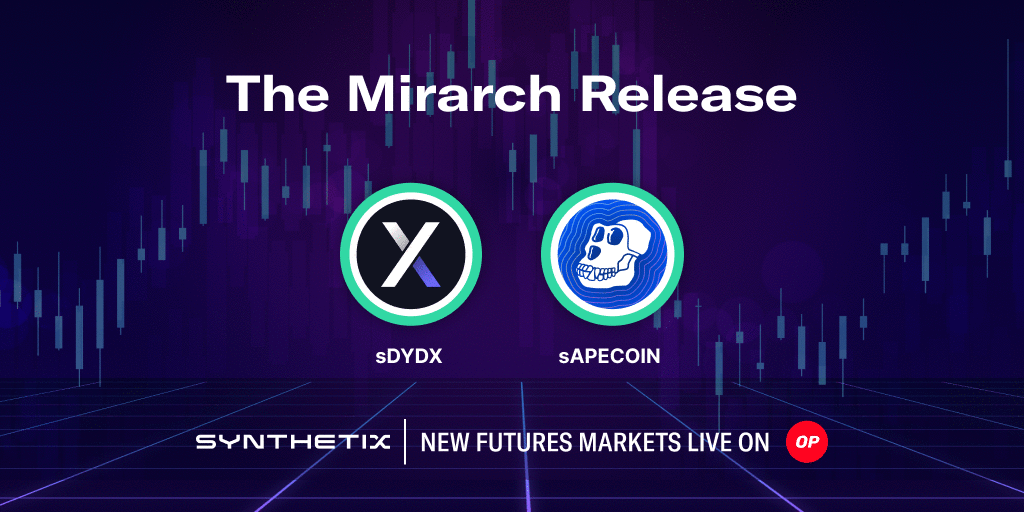The Mirarch release - Atomic Exchange, Fee Changes, New Markets, sUSD Bridge

Later today (5pm UTC, Tuesday, May 10th), the Mirarch release will begin. It will take approximately 3-4 hours to be completed. The bridge to deposit/withdraw SNX on/off Optimism will be paused during this release. Here's what’s included in this release:
- SIP-198: Update to Atomic Exchange Function: Allow trading at the pure the chainlink price for certain synths & remove the restriction on the Source or Destination Currencies being sUSD
- SIP-222: Update Exchange Fee System: Modify the current exchange fee system to compound source and destination synth fees rather than simply charging the rate associated with the destination synth.
- SIP-216: New synth: Indian Rupee on Optimism
- SIP-219: New futures market: ApeCoin on Optimism
- SIP-223: New futures market: DYDX on Optimism
- SIP-229: Optimism Bridge for Synths: Initially, only sUSD will be enabled for transfer
Are you interested in trading Synthetix Futures? Go to any Synthetix-powered trading frontend such as Kwenta.
SIP 229 - Optimism Bridge for Synths - Initially sUSD
Since SIP-165 has been implemented, sUSD is fungible between mainnet Ethereum and Optimism, though no bridges have been set up to send sUSD between layers.
Therefore, similar to how we currently deposit or withdraw SNX from L2, synths will be transferrable using the optimism bridge. A user will be able to call a public function on SynthetixBridgeToOptimism or SynthetixBridgeToBase to initiate a transfer to the other layer by burning synths grace period elapses, and the funds will be minted on the other side.
Chainlink feeds will track debt while synths are in transit between chains, allowing for synths to be bridged from L1 to L2
From the date of this deployment, there will be another day or two to finalize the chainlink oracles before its actually made available. Then the Optimism UI should be available by the end of this week to allow sUSD to be fungible between chains.
In summary: sUSD should be transferrable between chains by the end of this week. Additional announcements will follow.
SIP 216, 219, and 223: Indian Rupee Synth, ApeCoin, and DYDX Perpetual Futures
ApeCoin and DYDX Perpetual markets will join the growing list of supported cryptocurrencies available for leverage trading through Synthetix Perpetual Futures.
Synthetix is the first fully on-chain perpetual futures protocol to support ApeCoin and DYDX, and we’re very excited.
Are you interested in trading Synthetix Futures? Go to any Synthetix-powered trading frontend such as Kwenta.
Indian Rupees will also join the spot forex markets supported by Synthetix.
SIP 198 - Atomic Exchange Function Upgrades
Fee Reclamation - A Quick Refresher
Whenever a trade occurs on Synthetix on mainnet, there is a waiting period (10 mins). During this waiting period, users cannot exchange, transfer, or burn the Synth they have just traded into. This waiting period gives the oracles enough time to check the difference between the initial price and the new price — in other words, they check to see if a trade was affected by a lag in price updates. Read more about Fee Reclamation.
While this fee reclamation waiting period protects stakers from front-running, it is a subpar trading experience for most traders. On Optimism, block speeds are much faster, and speeds are lower, which is why fee reclamations aren’t necessary and oracle latency is much less of a problem on Optimism. Waiting 10 minutes to find out what price your trade settled at isn’t ideal for traders, which is why Atomic Exchanges were introduced.
Atomic Exchanges - Synthetix’s Mainnet Usecase
The atomic exchange function has been in effect since early November of 2021. This change provided a new exchange function allowing users to atomically exchange assets without fee reclamation by pricing synths via a combination of Chainlink and DEX oracles (Uniswap V3). Atomic Exchanges protect stakers from frontrunning and allow traders to access low slippage and low fees from Synthetix. This functionality will only be available on Ethereum's base layer (L1).
Atomic exchanges are the reason for most of Synthetix’s mainnet volume on Curve, 1inch, fixed forex, and many other aggregators and integrators. It is a powerful tool that leads to significant volume without frontrunnable risk because of the unique pricing model.
This upgrade changes two major things about Atomic Exchanges:
- Allow trading at the pure chainlink price for certain synths.
- Remove the restriction on the Source or Destination Currencies being sUSD.
An analysis run on both EUR and GBP, whereby we looked at the price differential between the pure chainlink price against the prices seen on centralized exchanges, reveals that Synthetix can provide highly competitive forex pricing without incurring the risk of oracle front-running.
Regarding the use case, synth stables on ETH have gained significant market share due to the integration with FixedForex project and demand for these synths on Curve Finance for farming purposes. At the time of writing, the synth-forex market cap is around $220m in various forex markets.
Hence, we should expect some volume with atomic forex trading across different curve pools for curve farming and an upcoming integration with Popcorn Finance.
Read more about the Atomic Exchange Function updates in SIP-198
SIP 222 - Exchange Fee Updates
Currently, the fee for an exchange is a function of the destination synth’s associated fee. The fee charged is now the sum of the current and destination synth.
Ex: If you're going from sUSD (fee = 0 bp) to sBTC (fee = 25bp) the total fee charged would be 25bps, the sum of the two.
In the current exchange fee system, a specific exchange fee is attached to each synth, and the fee charged for an exchange is determined by the destination synth’s fee. While this is sufficient for exchanges into and out of sUSD (or other fiat synths), it is less suitable for exchanges between volatile assets.
Exchange fees and oracle deviation thresholds are calibrated mainly to the price action for the USD pair. Exchanges between volatile assets are more likely to be frontrunnable.
The current system imposes an overly punitive fee between stable asset synths (fiat synths) due to the potential for front-running by trading into them from a more volatile asset. An indirect benefit of these updated fees is that fees for exchanges between stable asset synths can be lowered significantly.
Read more about the Exchange Fee updates in SIP-222
Any Questions?
This release is called Mirarch, which like all releases, is named after a star (in order of visual magnitude). If you've got any comments or questions about the release, please join the conversation on Discord.

